How To Grow Sedum
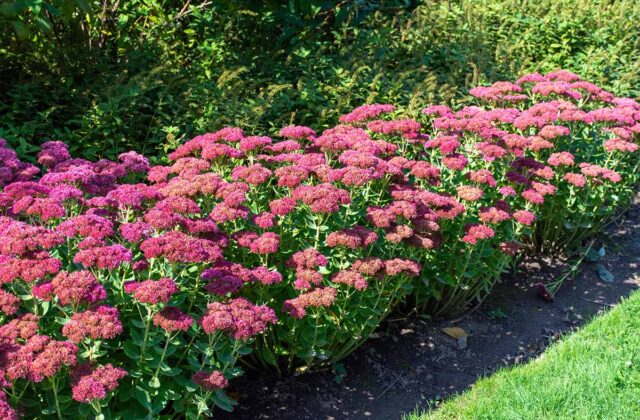
Introduction
Sedum praeltum, commonly known as “little fingers” or “immortelle.” Discovering how to grow Sedum is a rewarding journey for both novice and experienced gardeners, unlocking the secrets to cultivating these resilient and beautiful succulents. Here’s an overview of the plant:
- Scientific Name: Sedum praeltum
- Common Names: “Little fingers” or “Immortelle”
- Native Habitat: Native to Mexico
- Geographical Distribution: Found in both hemispheres, particularly in temperate zones and cold regions.
- Growth Characteristics:
- Highly developed succulent.
- Capable of growing over one meter in height.
- Requires minimum maintenance and effortless care.
- Resistant and durable evergreen foliage.
- Leaf Characteristics:
- Perennial leaves that remain green throughout the year.
- Fleshy leaves store water and nutrients for growth and flowering.
- Leaves can be whole, flat, or cylindrical.
- Flowering:
- Blooms in winter and spring.
- Inflorescences are generally cymose.
- Hermaphrodite flowers with white, yellow, or pink petals and fleshy sepals.
This description provides a comprehensive overview of Sedum praeltum, highlighting its adaptability as a succulent and its attractive features such as evergreen foliage and colorful flowers. Succulents, in general, are known for their ability to thrive in arid conditions and their unique water storage mechanisms in their fleshy leaves.
Types Of Sedums-Five Major Classes
In this plant genus, there exists a diverse array of species, each distinct from the others. All of these species are ideal for gardening beginners, requiring minimal care. Furthermore, they boast considerable aesthetic appeal.
Now, let’s introduce you to the five primary types of sedum. Discover their key features, which are sure to inspire you as you embark on home decoration.
Sedum Rubrotinctum
Hailing from Mexico, this particular Sedum is well-suited for container planting. Compact in size, it boasts a slightly creeping growth pattern, reaching up to 20 cm in height. Its distinctive feature lies in its cylindrical, fleshy leaves, which are predominantly light green but sport a reddish tip. This reddish hue is its most noteworthy characteristic. Come spring, it graces its surroundings with yellow blooms.
To ensure optimal coloration, it is recommended to position this Sedum in full sun, although it does exhibit tolerance for semi-shaded areas. It’s important to note that without ample sunlight, the leaves may not achieve the beautiful reddish tint. During the summer, regular watering is advised, and a well-balanced soil mix comprising sand, leaf mulch, and garden soil supports its growth. Minimal to no pruning is necessary for maintenance.
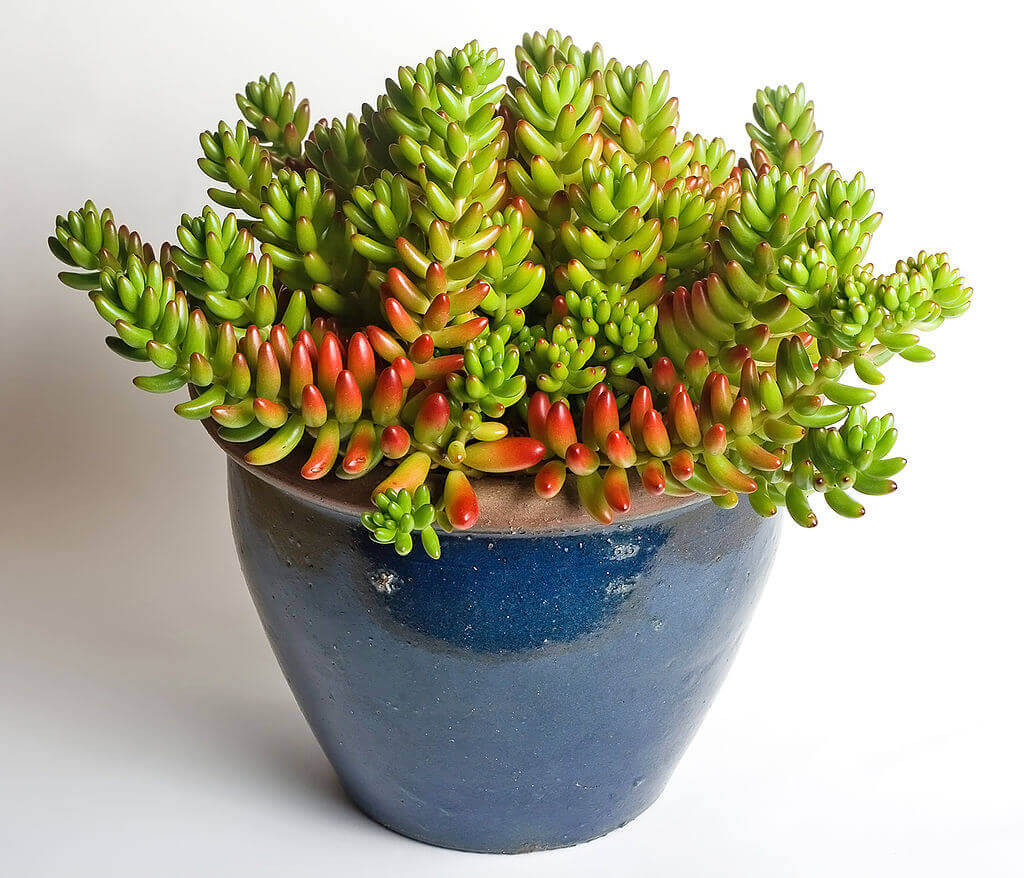
Sedum Reflexum
Commonly referred to as Cat’s Claw, holds significance as an ornamental wild plant. Among the smallest within its genus, it typically reaches a height of approximately 30 cm. Its distinguishing feature lies in its narrow leaves, which differ from other sedums. These leaves exhibit a green-grayish hue and are less densely packed due to their size. In May, this sedum adorns itself with petite yellow flowers.
Boasting rapid growth, Cat’s Claw can swiftly fill in spaces, making it advisable to plant each specimen at a safe distance from others. This sedum demonstrates resilience to frost and salinity, thriving even in impoverished or stony soils. Its robust and hardy nature positions it as a rustic and highly resistant species.
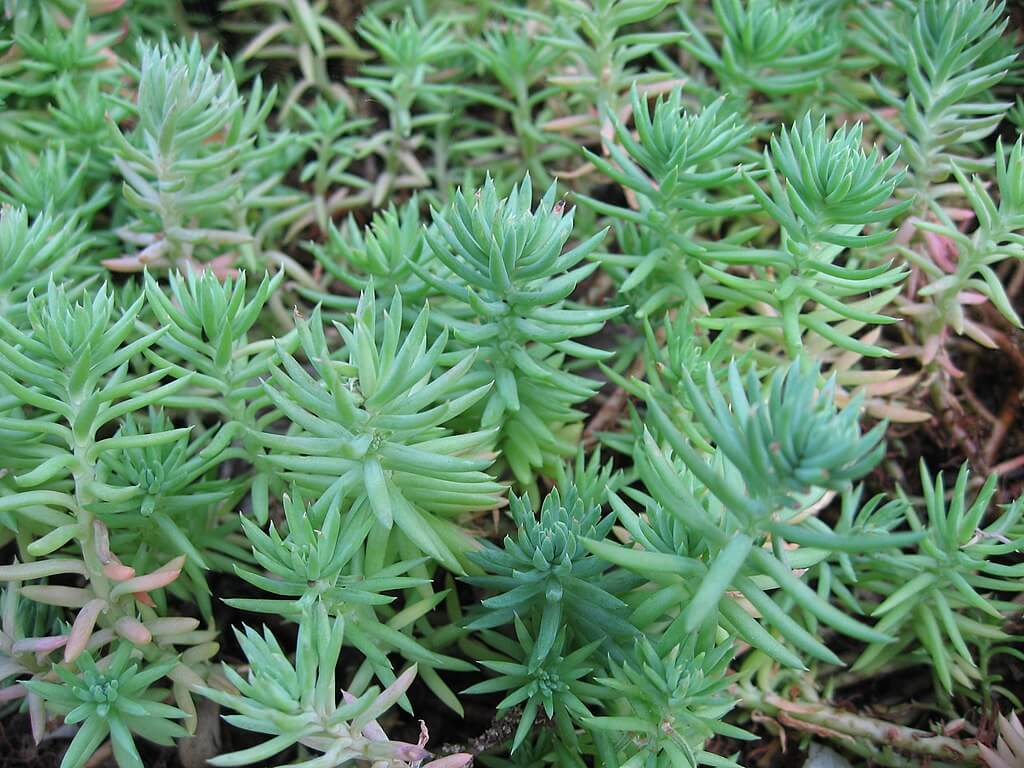
Sedum Morganianum
Commonly known as “burrito,” exhibits an initially erect posture that gradually transforms into a pendulous form over the years. With stems extending to approximately 40 cm in length, this succulent stores essential water and nutrients in its leaves, which, in typical fashion for this genus, are spear-shaped and closely packed. Sporting a distinctive bluish-green hue, the plant blooms in late spring, showcasing red or pink flowers.
Popular for both indoor and outdoor embellishment, Sedum morganianum is often cultivated in pots or hanging planters. While it can tolerate full sun exposure, it thrives in semi-shaded areas. Optimal growth is achieved in well-draining soil, and regular watering during the spring and summer months is recommended for its well-being.
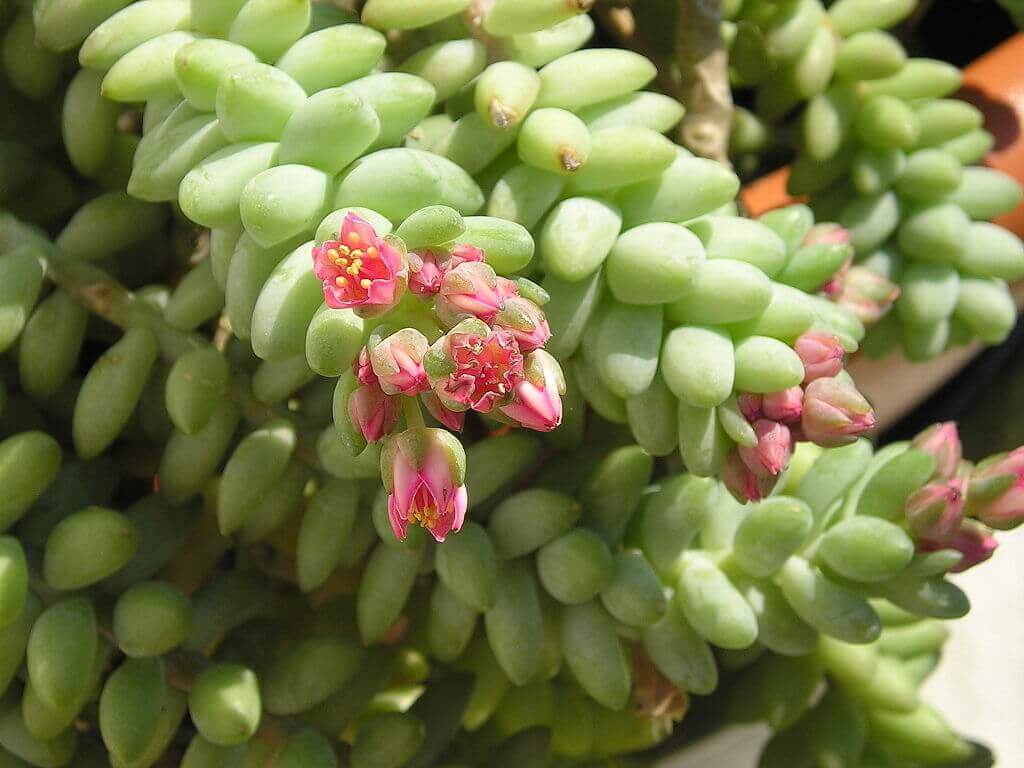
Sedum Acre
The sedum originating from Europe, particularly found spontaneously in the Iberian Peninsula, goes by the common name Pampajaritos or Pan de cuco. Characterized by its petite stature, it features creeping stems at the base that transition into an erect form at the top, typically reaching heights of 20 to 30 cm. The small, fleshy leaves have an almost flattened upper surface. Spring heralds its blooming season, adorned with petite star-shaped flowers boasting five vibrant yellow petals. This sedum variety is particularly well-suited for enhancing the aesthetics of walls or gardens.
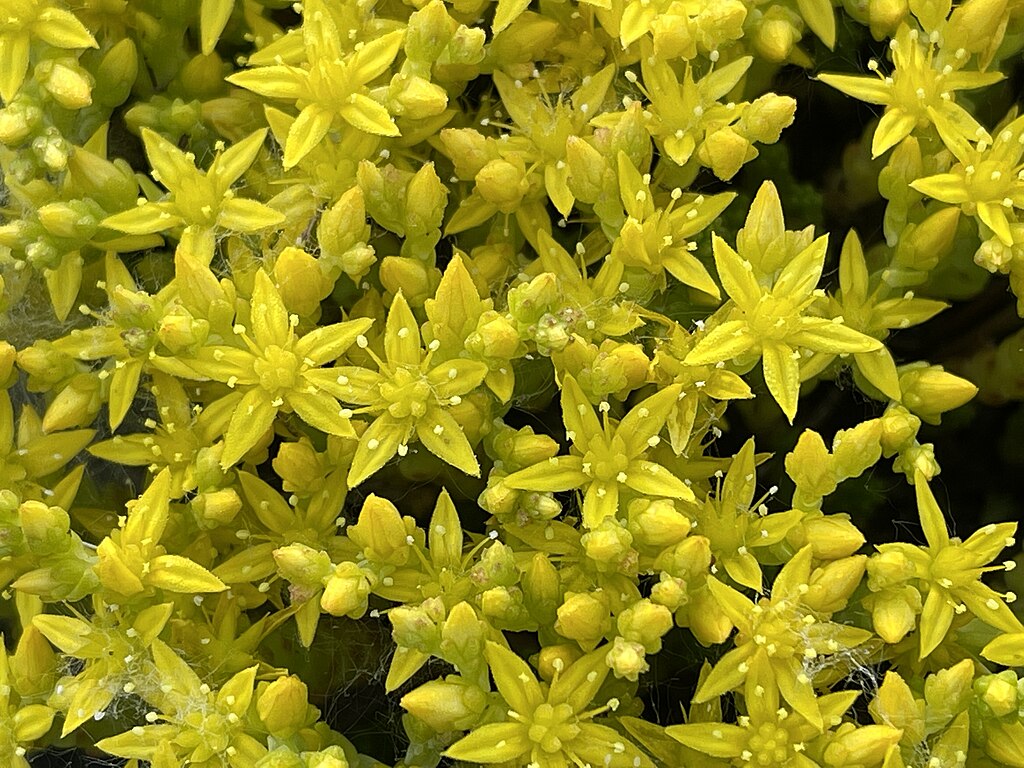
Sedum Sieboldii
This particular type is distinguished by its cascading form and substantial size. Within the genus highlighted today, this species stands out for the graceful elegance of its stems, some of which can extend beyond one meter in length. Featuring evergreen foliage, its succulent leaves serve as reservoirs for the necessary water and nutrients crucial for growth and flowering. These round, blue-gray leaves exhibit a reddish serrated edge, providing additional visual interest. The plant blooms in autumn, showcasing pink, star-shaped flowers arranged in terminal corymbs. Ideal for both indoor and outdoor settings, this sedum variant is particularly well-suited for planting in hanging pots.
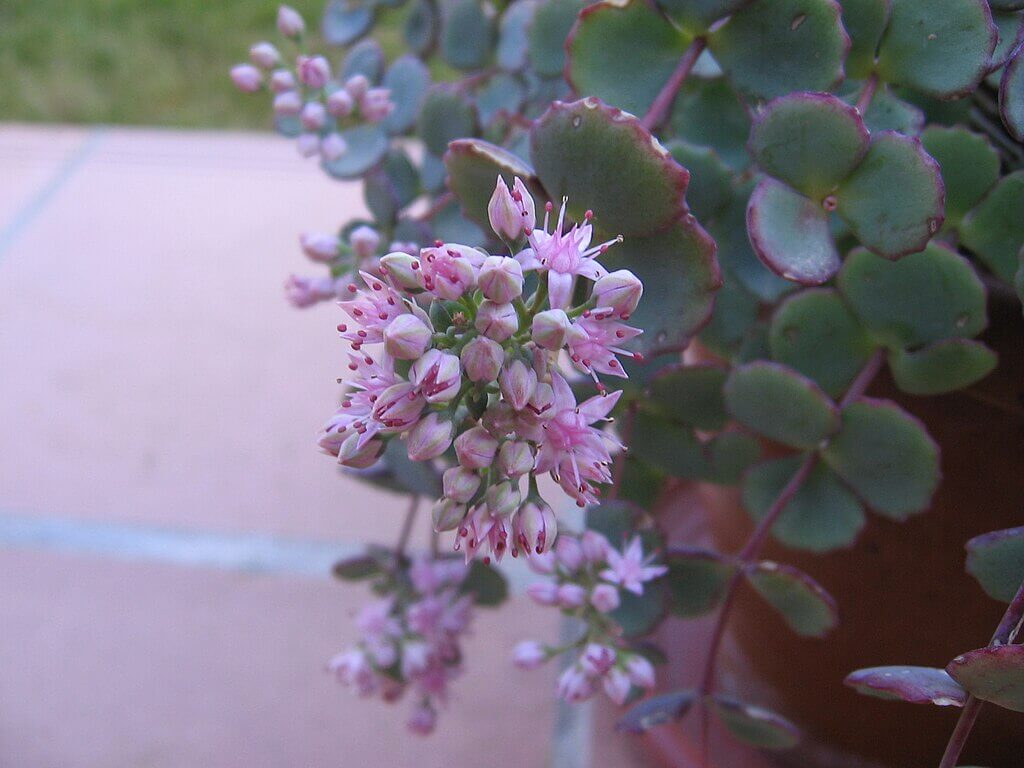
Benefits Of Growing Sedum In A Pot
Exploring the art of how to grow Sedum unveils the simplicity and elegance behind nurturing these low-maintenance plants, perfect for adding charm to your garden. Growing sedum in a pot can offer numerous benefits for indoor plants. Some of the main benefits are:
- Easy Maintenance: Sedum stands out as a resilient and low-maintenance plant, making it an excellent option for individuals with limited experience in plant care. Its hardy nature requires minimal attention, contributing to its appeal for hassle-free cultivation.
- Natural Decoration: The various sedum varieties offer a diverse array of colors and shapes, providing a decorative and naturally charming touch to any indoor space. Whether in pots or garden landscapes, sedum’s visual appeal enhances the aesthetics of its surroundings with ease.
- Air Purification: Similar to other indoor plants, sedum plays a role in air purification by absorbing toxins and releasing oxygen. Beyond its ornamental value, this quality makes sedum a valuable addition to interior environments, contributing to a healthier and more refreshing atmosphere.
What Is The Basic Care For Growing Sedum In A Pot?
Delving into the specifics of how to grow Sedum involves providing well-draining soil, ample sunlight, and periodic pruning, ensuring these hardy succulents thrive in various garden settings. Some important things to remember are as follows:
- Lighting: Sedum thrives with ample direct sunlight, necessitating placement near a sunny window where it can receive a minimum of 6 hours of light daily for proper growth.
- Watering: Resilient to drought, it’s crucial to avoid overwatering. Allow the soil to completely dry between watering sessions, preventing the pot from becoming waterlogged.
- Soil: Sedum prefers well-drained soil, making a succulent or cactus mix ideal. Enhance drainage by incorporating perlite or coarse sand into the soil mixture.
- Temperature: While resistant to cold, sedum prefers warmer temperatures. Maintain an environment with temperatures ranging between 18-24°C during the day, steering clear of cold drafts.
- Fertilization: Infrequent fertilization suffices for sedum. Apply a diluted liquid fertilizer once a month in spring and summer, avoiding fertilization during winter.
- Pruning: Although not frequently required, occasional pruning can involve trimming long or damaged branches to uphold a more compact and healthy appearance.
- Pests and Diseases: Resistant to pests and diseases, sedum may occasionally face threats from mealybugs or mites. If detected, employ a specific succulent insecticide for effective treatment.
- Propagation: Easily propagated through cuttings or divisions, simply cut a healthy branch and allow it to dry for a few days before planting it in a new pot with succulent soil.
It’s crucial to note that individual species of sedum may have unique care requirements. Therefore, researching the specific variety you have will enable you to provide tailored care for optimal growth and well-being. Armed with this basic knowledge, you can cultivate and enjoy the beauty of your sedum, enhancing the aesthetics of your home or garden. Happy gardening!
What Type Of Substrate Should I Use For Growing Sedum In A pot?
Mastering the techniques of how to grow Sedum involves understanding their water requirements, ensuring a balanced approach to irrigation for these drought-tolerant succulents. Using a well-draining substrate is highly advisable to ensure proper root development and prevent waterlogging for sedum plants. One effective mix is combining equal parts of potting soil with coarse sand or perlite. This blend enhances soil aeration and drainage. Additionally, a small amount of peat or coconut fiber can be added to retain moisture without risking excess.
Given that sedum is a succulent plant, it’s crucial to emphasize the intolerance to excessive water in its roots. Therefore, a substrate that facilitates good drainage is essential for maintaining a healthy and thriving sedum. This careful consideration of soil composition contributes significantly to the overall well-being of the plant.
How Can I Propagate Potted Sedum Successfully?
The process of how to grow Sedum is straightforward, with a focus on well-drained soil, adequate sunlight, and occasional division to propagate and expand your Sedum collection effortlessly. Here’s a step-by-step guide for propagating sedum from a stem cutting:
- Select a Healthy Stem: Choose a healthy, undamaged stem with at least 2-3 pairs of leaves to ensure successful propagation.
- Prepare the Pot: Fill a pot with a light, well-drained substrate, such as a mix of potting soil and perlite. Ensure the pot has drainage holes in the bottom.
- Cut the Stem: Use scissors or a sharp knife to cut the selected stem just below a leaf. This encourages the growth of new roots.
- Remove Bottom Leaves: Gently pull off the bottom leaves from the stem, leaving at least a couple of leaves at the top.
- Let the Cut Dry: Place the cut stem in a warm, dry location for a few days to allow it to dry and form a protective layer, reducing the risk of rot.
- Plant the Stem: Once the cutting is dry, make a hole in the potting substrate and insert the stem. Ensure it is firmly planted with the top leaves above ground level.
- Water Sparingly: Water the newly planted stem sparingly, avoiding saturation. Sedum tolerates dryness, so it’s crucial to prevent excess water.
- Place in Bright Light: Position the pot in a location with bright indirect light. Avoid direct sun exposure, as it may burn the leaves.
- Maintain Adequate Humidity: In the initial weeks, keep the substrate slightly moist but not overly wet. Occasionally spray water on the leaves for additional moisture.
- Wait Patiently: With time, the stem should develop roots and new leaves. Exercise patience and refrain from frequent handling, as this can hinder the rooting process.
Each plant has its own pace, and variations in rooting and growth times are normal. Patience and consistent care are key to successful propagation. By following these steps, you’re on your way to learn how to grow a thriving sedum houseplant.
Conclusion
In summary, cultivating sedum in a pot offers an excellent choice for indoor plant enthusiasts seeking to infuse beauty and elegance into their living spaces. This plant is low-maintenance, thriving with minimal water and indirect light, making it an ideal companion for gardening enthusiasts with limited time or experience. Nurturing them requires knowing how to grow Sedum in containers, allowing for creative arrangements on balconies or patios while maintaining the unique characteristics of these resilient succulents. Furthermore, the versatility of sedum allows it to adapt seamlessly to various pot types and interior designs, bringing a breath of fresh, natural air to any environment. Don’t hesitate—take the plunge, learn on how to grow sedum in a pot, and relish in the beauty of its leaves and flowers throughout the year!
Best of luck, and may your new plant bring beauty and greenery to your space! If you have any more questions or need further assistance, feel free to ask. Happy gardening!
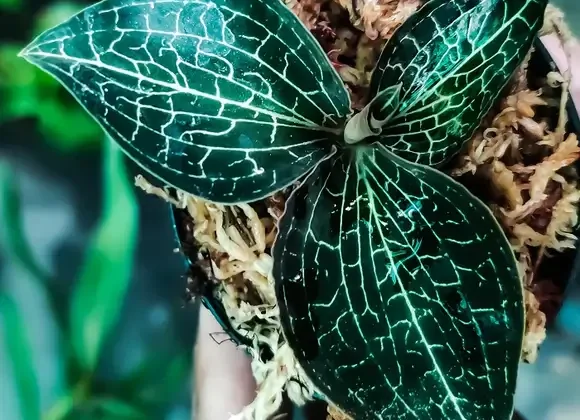
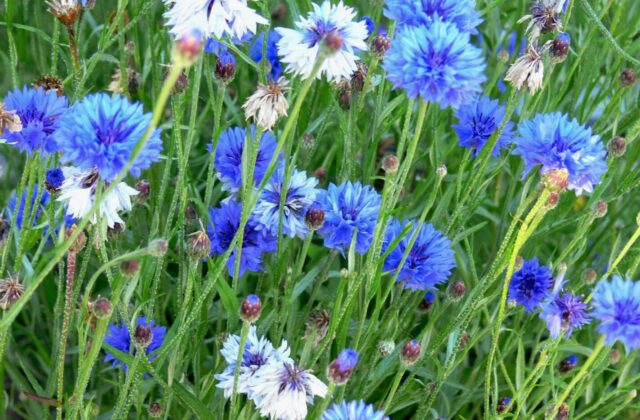
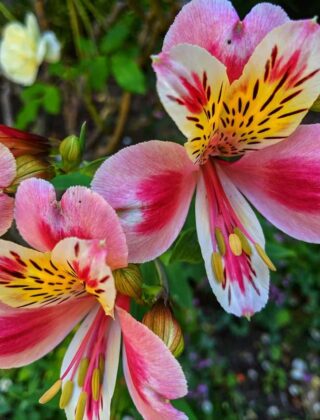
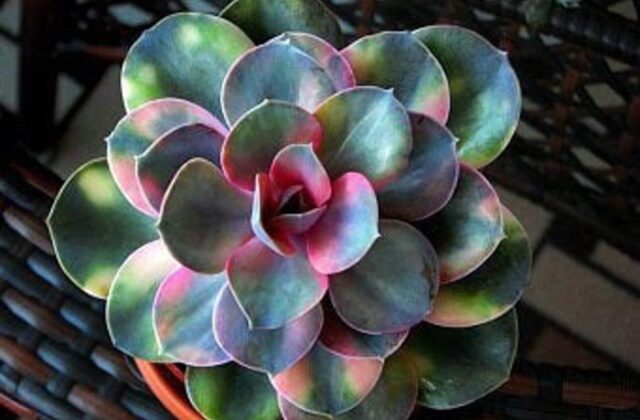
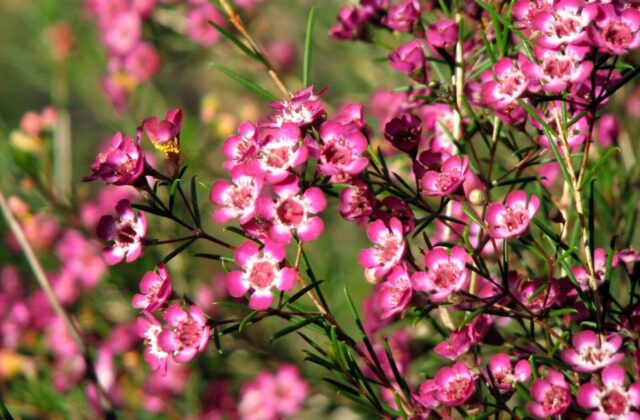
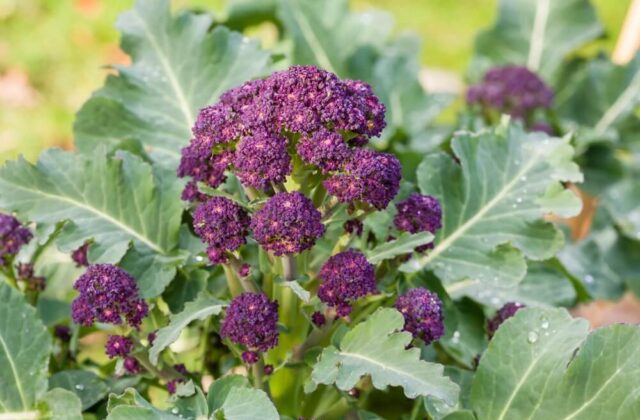
13 comments
Good day! I could have sworn I’ve been to this website before but after browsing through
some of the post I realized it’s new to me. Anyways, I’m definitely happy I
found it and I’ll be book-marking and checking back often!
My web page; vpn special coupon
Spot on with this write-up, I really feel this website needs a great deal more attention. I’ll probably
be back again to read more, thanks for the advice!
My web blog … vpn coupon code 2024
Hi, i feel that i noticed you visited my site so i got here to
go back the prefer?.I’m trying to to find things to enhance my
website!I suppose its good enough to use a few of
your ideas!!
Here is my web-site – vpn coupon 2024
Nice blog here! Also your site loads up very fast!
What web host are you using? Can I get your affiliate link to your
host? I wish my web site loaded up as quickly
as yours lol
Also visit my blog :: vpn code 2024
Everything is very open with a really clear explanation of the challenges.
It was definitely informative. Your site is very helpful.
Thank you for sharing!
Also visit my blog post – vpn special code
Howdy! This is my first visit to your blog! We are a group of volunteers and starting a new initiative in a community in the same niche. Your blog provided us beneficial information to work on. You have done a outstanding job!
I got what you mean , appreciate it for putting up.Woh I am pleased to find this website through google. “I would rather be a coward than brave because people hurt you when you are brave.” by E. M. Forster.
I don’t think the title of your article matches the content lol. Just kidding, mainly because I had some doubts after reading the article.
Thanks for sharing. I read many of your blog posts, cool, your blog is very good.
Your ideas absolutely shows this site could easily be one of the bests in its niche. Drop by my website UY6 for some fresh takes about Thai-Massage. Also, I look forward to your new updates.
Your article helped me a lot, is there any more related content? Thanks!
Your point of view caught my eye and was very interesting. Thanks. I have a question for you.
Your article helped me a lot, is there any more related content? Thanks!